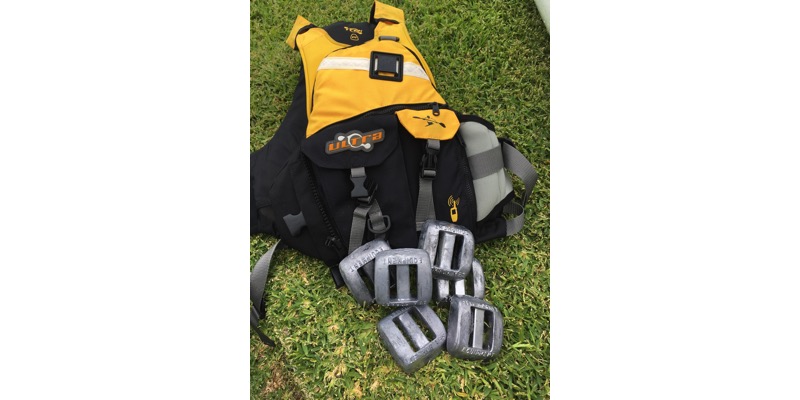Paddler Weight and Stability

Editor: Over the last two years, I've lost about 12kg. With the weight loss and comcommitent fitness increase, my performance has improved. But I've noticed a slight increase in tippiness over the last year or two that I'd put down to my increasing age... But is it also perhaps related to my weight? Angus Gluskie has done some great work on this very issue...
Does paddler weight affect the characteristics of a surf ski, such as stability? With paddler weight varying dramatically, and the potential impact large, this must surely be a highly important issue for surf ski paddlers, yet one which seems to be frequently overlooked, despite being fundamental to ski performance.
We can put the issue of speed to one side. The impact of weight on speed is well documented. Added weight increases the volume of the hull in contact with the water, and the drag reduces speed at around 1/6th of the percentage increase in weight.
But what happens to stability? The generally accepted concept is that a larger paddler weight increases stability. But is this really correct?
Factors
There are several factors that would appear to decrease stability as paddler weight increases:
- Added paddler weight may raise the centre of gravity
- Added paddler weight could increase the momentum accompanying ski rotation
- Paddler weight also changes the position of the waterline relative to the hull. For heavier paddlers, the waterline may sit where the sides of the ski are more vertical – which would decrease stability.
- For lighter paddlers the waterline would sit where the hull has greater curvature which would increase stability. (The greater hull curvature results in more water displacement and resistance on the side of the ski dipping into the water, than on the side rising out of the water).
Importantly the rationale for considering the impact of weight and stability is NOT to suggest anyone should be carrying extra weight on a ski. The point is to consider whether for optimum speed and stability surf skis need to be proportioned to accommodate different weight paddlers. For example, a shorter V12 may prove to have a better combination of speed and stability for an 80kg paddler than a 6.4m fully sized V12.
With these questions in mind, I thought it may be worth doing some practical testing, and I’ve described the results below. The tests I conducted are highly subjective, brief, limited in scope, largely unscientific and most definitely prone to error. Nevertheless the tests did start to provide some practical insights.
Tests
The most obvious limitation was that I was adding dead weight, not live weight, and could not replicate the way increases in body weight would be distributed over a whole body.
For safety I ran preliminary-tests in a pool. This gave me a rough idea of what was going to happen and enabled me to confirm that remounts were feasible. The weights attached to my body were dive weights which could be jettisoned if needed, and I was wearing a life jacket sufficient to provide floatation to the total weight. There is a fine line between being buoyant and sinking. When close to neutral buoyancy, the addition or subtraction of a single dive weight was enough to swing the pendulum from buoyant to sinking or vice versa, and I wanted to be on the right side of that equation.
The next step was to run some tests out on the water proper. The bare paddler weight was 68kg, ski was a Stellar SES Excel 11kg, and on my first trials conditions were 5-7knots, with a small wind chop and mild boat wakes. Apart from an initial, longer run, the tests involved paddling the ski (with differing weight configurations) for around 5 minutes each over a short circuit involving paddling into wind, wind behind, wind across, a sharp turn and some manoeuvring into a landing zone. Tests 7 and 8 were 20 minute runs on a separate day in heavier conditions 10-12 knots.

Image 1: Neither pretty nor scientific but this was one way to add successive increments of 5kg under paddler thighs. For safety this weight is secured to the ski not paddler.

Image 2: Adding successive weights at waist level for the trial.
Test 1: Base Case No Weight Added
Took the ski for a 45 minute paddle to get a good feel for the normal set-up. Wind was stronger than the later tests (around 12 knots) and a greater number of boat wakes. Boat performed well in all directions, riding satisfactorily over 2 foot wakes taken broadside, some bounciness could be felt broadside to wind-chop.
Test 2: Added 10kg to Paddler Torso (dive weights added to life jacket - approximately waist level)
Very large increase in sensation of instability. Needed to carefully control body movements and paddling stroke to avoid taking a dive. I believe the dominant effect here was that the added weight raised the centre of gravity and that this overwhelmed any other benefit that may have accrued from the added weight. This was surprising as the added weight at waist level was only fractionally higher than hip level where I believe the centre of gravity for a paddler normally sits.
Test 3: Added 10kg near Paddler Thighs (weights added directly under lower thighs)
Moderate increase in the resistance of the ski to outside factors. The sensation of the ski bouncing over a broadside wind-chop disappeared. There were no problems in paddling aggressively. Felt a little bottom heavy requiring the paddler to manhandle the ski. I would interpret these outcomes as (a) the weight slightly lowering the centre of gravity and (b) the added weight increasing the inertia of the ski relative to outside factors such as the force of a wave.
Test 4: Added 5kg near Paddler Thighs and 5kg to Paddler Torso (waist height)
Moderate increase in the resistance of the ski to outside factors. The sensation of the ski bouncing over a broadside wind-chop disappeared. There were no problems in paddling aggressively. Felt less bottom heavy than Test 3. I suspect this test did not change the centre of gravity from the base case (with weight added both higher and lower) and accordingly this may most closely represent a heavier paddler of similar weight distribution to a lighter paddler. As the results were similar to Test 3, it suggests that the dominant factor in Test 3 may have been increasing the inertia of the ski, rather than lowering the centre of gravity.
Test 5: Added 10kg near Paddler Thighs and 10kg to Paddler Torso (waist height)
Moderate increase in the resistance of the ski to outside factors, but NOT noticeably more than Test 3 or 4. The added weight at waist height increased the sensation of instability, despite this being balanced by added weight at the thighs. A doubling of the added weight should have improved the inertia benefit, however overall stability declined. While it was possible the stability was lower due to the higher waterline relative to the hull curve I don’t believe this influence was material. A second explanation is that the greater dead weight around my waist restricted my ability to manoeuvre my body. This test may represent the situation for a heavier paddler who struggles to manoeuvre their body effectively. While the added weight may improve inertia, it was more difficult to keep the weight balanced.
Test 6: No Weight Added
This was a re-check of the base case. The general stability was no different to test 3 and 4. The ski was easier to manoeuvre and accelerate. However the ski was definitely more bouncy across a broadside chop than in the tests carrying extra weight.
Test 7 & 8: Re-Tested 5kg near Paddler Thighs and 5kg to Paddler Torso and compared to Base Case (No added weight) in heavier conditions
The increased weight again reduced the sensation of bounciness in light chop, however this difference was eliminated once the wind chop was larger. Stability appeared better in the Base Case (no weight added) in the heavier conditions, with the lighter configuration feeling much more balanced when cresting over the peak of a swell or taking boat wakes and chop broadside. My interpretation here was that a 10kg weight differential can resist a small amount of wave force, but is quickly overwhelmed as the wave forces rise. Once again, the ability to manoeuvre the body effectively was the far more significant factor for stability, and it was clear that dead weight impeded this.
Concluding Thoughts
Ski stability appears to be a product of (a) hull shape near the waterline (b) centre of gravity and (c) the ability of the ski to resist external forces through (c.1) inertia (dead weight) and (c.2) effective body positioning.
Assuming that the ski is sufficiently sized relative to the paddler, the hull shape (a) should be a non-issue for paddlers of different weight, but would be an issue if the paddler was too heavy for the ski. Photo 3 shows how far the waterline changed for an increase in weight of 10kg and 20kg.

Image 3: Adding 10kg and 20kg only raised the waterline by a small amount.
Centre of gravity (b) potentially has a large impact, and does vary for paddlers of differing builds. It is possible an individual with more relative weight in the legs may have greater inherent stability in a ski than an individual with more relative upper body weight. However an increase in paddler weight that is proportionate across the paddler’s body may not change the centre of gravity or stability.
The inertia or dead weight (c.1) of the ski and paddler clearly has some impact on stability, with the influence relating to how fast, how slow, and how much the ski will be pushed around by the sea. The ability to resist the sea conditions will depend on the weight of paddler and ski relative to the surface area of the ski impacted by the force of the sea (ie not all of a ski’s surface area is affected by a wave). For example, the force of an approaching wave may be spread over only a few centimetres of exposed hull above the waterline, but for some or all of the length of the ski. This force will be resisted by the weight of the paddler and ski on the other side of that hull.
In the tests, 10kg of weight differential seemed to resist small wave chop not large. It would be logical to think that larger weight differentials may be more effective in resisting larger conditions.
Importantly while this theory makes sense it is worth considering that in the tests this inertia factor was only reflected in the presence or lack of bounciness, it did not tip me out, and it was much less of a factor than body position and manoeuvrability.
The paddler’s ability to successfully manoeuvre their body weight to counteract the influence of the sea (c.2) is clearly one of the most significant influences on stability and it far outweighed every other factor in the tests. I include in this category the paddler’s ability to generate speed and acceleration. While manoeuvrability is attributable to experience, technique and flexibility - the impact of this in resisting wave forces will also have some linkage to weight. For example, in theory an efficiently positioned 100kg body will provide greater resistance per metre of ski to a wave than an efficiently positioned 80kg body.
Possible Conclusion
The possible conclusion for ski designers – is that to have the same resistance/inertia characteristics – ski size (predominantly length) would need to be proportioned to the combined weight of paddler and ski. IF the relationship was straight line ( I’m not sure that is the case), this would suggest that if 6.4m is an ideal ski length for a 90kg paddler and an 11kg ski, you could achieve the same stability in a proportioned ski at around 5.7m for an 80 kg paddler, 5.1m for 70kg, and 4.5m for 60 kg.
However this would also need to be considered against any impact that changed length may have on speed. I note that Ralph Baker’s work on optimal length for speed shows 6.0m +/- 0.5m as optimal for a 90kg paddler and 5.3m +/- 0.5m as optimal at 70kg (assuming a ski weight similar to my example), with a greater penalty for being too short, and only a small penalty for being too long.
I also note Ralph Baker’s conclusions that optimal performance from a ski would be obtained by tailoring ski size to the individual athlete’s physical attributes – particularly weight.
The current suite of elite skis on the market vary in size from 6.1m to 6.4m, which appropriately appears to err on the side of greater length, but which is clearly a far more limited range than Ralph Baker’s work on speed and my very rough testing on paddler weight suggests. The recent introduction of the Epic V11 at 5.8m opens this range a little wider. I believe high end rowing sculls are made in several sizes optimised for rower weight.
A final consideration that cannot be discarded without more accurate testing is whether there are other quite separate advantages – even in stability - from having a lighter (not heavier) paddler to ski-size ratio. One possible advantage is that the lighter ratio causes the ski to ride over, rather than sit down in, the sea conditions. In the tests conducted I personally considered this to be a positive characteristic.
Adding dead weight is an imperfect way to test these relationships, and in terms of live weight paddlers can’t quickly add or subtract 20kg of muscle to run a comparison. Accordingly it will be interesting to see if designers with the requisite facilities are able to test these theories more and confirm one way or the other whether there are material speed and stability benefits from skis optimised for paddler weight and size.
A.J.Gluskie

